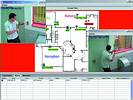

The key to effective building management, incorporating access control, CCTV surveillance and recording systems, is the ability to do so without over extending the capabilities of the control room operator. The vast amount of information that is streamed to the control room by the various systems places exceedingly high expectations on the control room operator who is expected to act vigilantly and diligently throughout a shift, which could last between 8 to 10 hours.
During the shift the operator may be expected to monitor in excess of 20 cameras as well as online viewing of the access control system. The greater the amount of information the operator has to disseminate and respond to the greater the margin for human error and risk to overall security. In the event of a security violation it is certainly not realistic to expect an operator to, without fail, respond swiftly and appropriately to each and every event. In larger control rooms where remote locations are monitored, the effective implementation of corrective procedures becomes even more difficult for an operator to contend with and of course increases the element of risk.
Sifting out redundant information
The need to harness the wealth of information generated by the different systems and to translate it into an easy to operate format has been acknowledged and effectively addressed through the combined efforts of Impro Technologies and Mirasys, a Finnish company. Together these companies have developed an integrated access control and CCTV surveillance and recording module.
According to Impro Technologies' Gerrie Van Tonder, the architecture of the integrated system comprises the access control server, the CCTV, DVR (digital video recording server) and an integrated module that can be installed on the access control server or on a standalone PC.
"With the integrated system all the features of both the access control and the CCTV system are available with the added advantages of the integrated module," he says.
"The integrating module makes it possible to effectively control remote sites from a central control room. The architecture on the integrated module comprises an active floor plan displayed on a PC monitor, combined with video display boxes, displaying realtime video and access control icons and pop-up dialog boxes displaying access control alarm events, tag holder details and operator instructions," says Van Tonder.
"The video display boxes displayed on the floor plans as well as the access control icons and dialog boxes are activated by predetermined events. These predetermined events can, for example, be video alarms, motion detection, loss of video or external alarm inputs or access control alarms where the access control alarms include door forcibly opened, doors that remain open too long or denied tags."
The ability to have multiple monitors off one PC enhances the integration even further, he adds. "The operator can now have the ImproNet GUI (graphic user interface) on the first monitor and as the cameras are triggered he can drag the viewing window onto the adjacent monitor. This allows the operator to maximise the CCTV window without losing the functionality of the GUI."
The examples below serve essentially to demonstrate the flexibility of the system.
* For a high security area with low volume traffic, positive video identification can be done before the control room operator opens the door. The system is configured to display the tag holder detail and identity photograph on the screen when the tag holder presents his tag to the reader. The reader will deny access to the tag holder and this denied event will trigger the video display box on the floor plan. An audio alarm in the control room will alert the operator and the visual aids will indicate to the operator, that a person wishes to enter. The operator can now compare the realtime video with the tag holder information and if the operator is satisfied that the tag holder can be positively identified the operator can open the door from the control room. The alarm conditions can then be removed from the screen.
* If a high security door needs to be monitored, the following procedure can be followed. A door forced open event can be used to activate the video and operator instruction pop-up dialog boxes, if required. An audio alarm will alert the operator to take action.
For more information contact Gerrie Van Tonder, Impro Technologies, 011 476 9186, [email protected], www.impro.net

© Technews Publishing (Pty) Ltd. | All Rights Reserved.